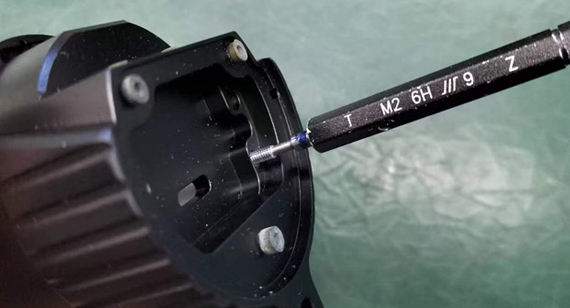15 years one-stop China custom CNC machining parts factory

Hey there I’m VMT Sam!
With 25 years of CNC machining experience we are committed to helping clients overcome 10000 complex part-processing challenges all to contribute to a better life through intelligent manufacturing. Contact us now
 453 |
Published by VMT at Dec 23 2023
453 |
Published by VMT at Dec 23 2023
Risk analysis after the thread of CNC machining parts passes the stop gauge
With the widespread application of CNC machining technology, more and more parts are processed into shapes with specific threads. After passing the pass-and-stop gauge inspection, these parts are often considered to meet the design requirements and can enter subsequent assembly and use. However, even if it passes the go-no-go gauge inspection, there are still some potential risks associated with CNC machining part threads. This article will analyze these risks and propose corresponding preventive measures.

1. Risks after the thread of CNC machined parts passes the stop gauge
Surface quality risk
Although go-no-go gauge inspection can ensure that the size and shape of the threads meet the design requirements, it cannot completely guarantee their surface quality. During the CNC machining process, defects such as scratches and burrs may appear on the thread surface due to tool wear, improper cutting parameter settings, etc. These defects may cause problems such as loosening and wear of parts during subsequent assembly and use, thus affecting the performance and life of the product.
Stress concentration risk
During CNC machining, stress concentration may occur due to the interaction between the tool and the material. When stress is concentrated on the thread, it may cause the thread to loosen or break. In addition, if the transition area of the thread is not handled properly, it may also cause stress concentration, thereby affecting the reliability and stability of the part.
Dimensional accuracy risk
Although pass-and-stop gauge inspection can ensure that the size of the thread meets the design requirements, in the actual production process, due to changes in material properties, processing errors, etc., there may be a certain deviation between the actual size of the thread and the design size. This deviation may cause problems such as poor fit and looseness of parts during subsequent assembly and use, thereby affecting the performance and life of the product.

2. Preventive measures
Improve surface quality
In order to improve the surface quality of the threads of CNC machined parts, the following measures can be taken:
(1) Choose high-quality cutting tools and materials to ensure sharp cutting tools and stable materials;
(2) Set cutting parameters reasonably to avoid excessive cutting force and cutting heat;
(3) Check and replace cutting tools regularly to ensure they are sharp;
(4) Use appropriate coolant to reduce cutting temperature and material deformation.
Optimizing stress concentration problems
In order to optimize stress concentration problems, the following measures can be taken:
(1) Reasonably select cutting tools and cutting parameters to avoid excessive stress;
(2) Smooth the thread transition area to avoid stress concentration;
(3) Perform heat treatment or vibration aging treatment on the parts to eliminate stress concentration.
In order to improve the dimensional accuracy of the threads of CNC machined parts, the following measures can be taken:
(1) Select accurate measuring equipment and measurement methods to ensure the accuracy of measurement results;
(2) Regularly inspect and calibrate equipment and tools to ensure their accuracy and stability;
(3) Strengthen the monitoring and management of the production process to avoid processing errors;
(4) Rework or scrap unqualified products to avoid affecting the quality stability of mass production.
3. Summary
There are still some potential risks after the thread of CNC machined parts passes the stop gauge, such as surface quality risk, stress concentration risk and dimensional accuracy risk. To ensure product performance and longevity, appropriate precautions need to be taken to reduce these risks. Looking to the future, with the continuous development of science and technology, CNC machining technology will become more advanced and mature. At the same time, the risk control for the threads of CNC machining parts will also be more stringent and precise. We believe that in the future development, CNC machining technology will make greater contributions to the development of manufacturing industry.
Ready To Start Your Next Project?
Get Instant Quote

Request a Free Quote
Send us a message if you have any questions or request a quote. We will get back to you ASAP!